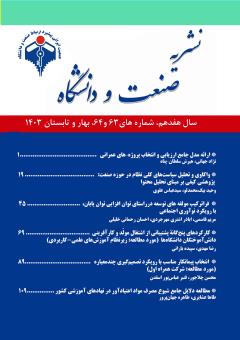مطالعه دلایل جامع شیوع مصرف مواد اعتیادآور در نهادهای آموزشی کشور
محورهای موضوعی : Special
طاها عشایری
1
![]() ,
طاهره جهان پرور
2
,
طاهره جهان پرور
2
![]()
1 - استادیار دانشكده علوم اجتماعي و عضو هئیت علمی گروه تاریخ و علوم اجتماعی علوم اجتماعي دانشگاه محقق اردبیلی، اردبیل، ایران
2 - دانشجوی دکترای جامعه شناسی فرهنگی، گروه علوم اجتماعي دانشكده علوم اجتماعي ارتباطات و رسانه، دانشگاه آزاداسلامی، واحد تهران
کلید واژه: مصرف مواد مخدر, نهاد مدرسه, ساختار خانواده, دانشآموزان, ناکامی تحصیلی,
چکیده مقاله :
مصرف مواد اعتیادآور (دخانیات و مواد مخدر)، مسئله اجتماعی-فرهنگی است که شیوع و عادی آن شدن در میان گروه سنی و طبقات دانشآموزی (نظام آموزشی-مدارس)، فرایند توسعه، پیشرفت و سرمایه انسانی را با بحران و اختلال مواجه ساخته و منجر به طولانی شدن گذار توسعهای، بیسازمانی اجتماعی کلان اقتصادی و مهمتر از همه ناپایداری، زوال و فروپاشی نهاد خانواده میگردد. بر این اساس هدف اصلی پژوهش مطالعه دلایل جامع شیوع مصرف مواد اعتیادآور (دخانیات و مواد مخدر) در میان دانشآموزان به روش فراترکیب است. روش پژوهش از نوع استقرایی فراترکیب کیفی در بازه زمانی 1382 الی 1403 است که به روش نمونهگیری غیر احتمالی (تعمدی) از 115 اسناد علمی (استخراجشده از پایگاه علمی نورمگز، مگ ایران و ایران داک)، بعد از غربالگری و گزینش، 74 سند علمی بهعنوان حجم نمونه انتخاب و وارد فاز تجزیهوتحلیل با نرمافزار Excell وMaxqda 2022 شدند. نتایج نشان میدهد که عوامل چندگانه اجتماعی (نابسامانی خانوادگی، کژکارکردی سرمایه اجتماعی، الگوی مرجع منفی محیط بزهکارانه، ضعف سرمایه اجتماعی خانوادگی، بیسازمانی اجتماعی)، اقتصادی (فشارهای اقتصادی، آنومی اقتصادی، شکاف رفاهی-طبقاتی)، فرهنگی (سبک تفریحی ناسالم؛ آگاهی و نگرش؛ الگو و شیوههای تربیتی، هنجارپذیری موادمخدر؛ تعامل ضعیف مدرسه-دانشآموزان، بیگانگی تحصیلی، بحران آموزشی، ناکامی تحصیلی، کاهش تعهدهای مذهبی)، روانی (بحران محبت، بیگانگی روانی، اختلال رفتاری-روانی، ضعف مهارتهای فردی)، جمعیتی (فردی، سطح تحصیلات-شغل) در شیوع مصرف مواد اعتیادآور میان دانشآموزان مؤثر بوده است
Addictive substance use (tobacco and drugs) is a socio-cultural issue whose prevalence and normalization among school-age groups and student populations (educational institutions/schools) disrupts development, progress, and human capital, prolongs developmental transitions, causes macro socio-economic disorganization, and—most critically—leads to instability, decline, and the breakdown of the family institution. Accordingly, the primary objective of this research is to comprehensively study the causes of widespread addictive substance use (tobacco and drugs) among students using a meta-synthesis approach.
The research employs a qualitative inductive meta-synthesis method, covering the period from 2003 to 2024. Using non-probability (purposive) sampling, 115 scientific documents (extracted from Noormags, Magiran, and IranDoc databases) were screened, with 74 documents ultimately selected as the sample size. Data were analyzed using Excel and MAXQDA 2022
The results indicate that multiple factors contribute to the prevalence of addictive substance use among students, including:
Social factors (family dysfunction, social capital dysfunction, negative role models in delinquent environments, weak family social capital, social disorganization)
Economic factors (economic pressures, economic anomie, welfare-class disparities)
Cultural factors (unhealthy leisure styles; awareness and attitudes; parenting models and methods; normalization of drug use; weak school-student interaction; academic alienation; educational crisis; academic failure; declining religious commitments)
Psychological factors (affection crisis, psychological alienation, behavioral-psychological disorders, lack of individual skills)
Demographic factors (individual factors, education level, occupation)
These findings highlight the complex interplay of structural, cultural, and individual dimensions in the spread of substance abuse among students
